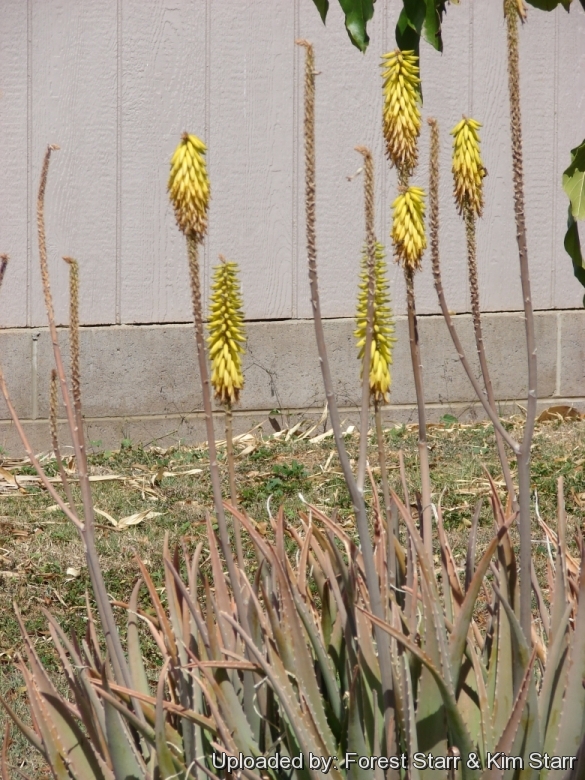
Leaves and flowers at Pukalani, Maui, Hawaii (USA). March 02, 2007.
It is a popular houseplant with a long history as a multipurpose folk remedy. Aloe vera is widely cultivated and plus than 150 different clones and variety are available.
Origin and Habitat: Aloe vera probably originated in northern Africa (Algeria, Morocco, and Tunisia, along with the Cape Verde Islands, Canary Islands, Maderia) but diffused and cultivated throughout the world.
The species is widely naturalised elsewhere, occurring in temperate and tropical regions of Australia, India, Vietnam, Taiwan, Barbados, Belize, Nigeria, Paraguay and the USA. It has been suggested that, like many Aloes, the species is originally from Southern Africa and that populations that occur elsewhere are the result of human cultivation.
Altitude range: 0 and 1300 metres above sea level.
Habitat and ecology: Hammocks, sandy areas, roadsides and similar places in full sun. Like other Aloe species, Aloe vera forms arbuscular mycorrhiza, a symbiosis that allows the plant better access to mineral nutrients in soil.
Synonyms:
See all synonyms of Aloe vera
back
Accepted name in llifle Database:Aloe vera (L.) Burm.f.Fl. Ind. (N. L. Burman) 83 (1768).Synonymy: 24
back
Common Names include:
ENGLISH: First Aid Plant, True Aloe, Indian Aloe, Chinese Aloe, Lily of the Desert, Curaçao aloe, Burn Aloe, Aloe edge, Aloe of Curaçao, Aloe-tree, Coastal aloe, West Indian aloe, Star cactus, Mediterranean aloe, Jaffarabad aloe, Barbados aloe, Medicinal aloe, Unguentine cactus, Burn plan, Aloe, Aloe vera, Common aloe, Chinese aloe
ALBANIAN (Shqip): Aloe vera
ARABIC ( لعربية ): صبر حقيقي, الألوه نبات, الألوة
AZERBAIJAN ( Azərbaycanca): Əsl əzvay
BASQUE (Euskara): Aloe vera
BENGALI (বাংলা): ঘৃতকুমারী, Ghrita kumari, Kumari
BOSNIAN (bosanski / босански): Aloa
BULGARIAN (Български): Алое вера
CATALAN (Català): Bàlsam de jardí, Sèver de jardí, Atzavara vera, Àloe vera
CHINESE (中文): 庫拉索蘆薈, 龙舌兰
CZECH (Čeština): Léčivá aloe, Aloe pravá
DANISH (Dansk): Lægealoe
DUTCH (Nederlands): Aloë vera, Aloë
ESPERANT (Esperanto): Aloo vera
FILIPINO: Aloeng medisinal, Aloe vera
FINNISH (Suomi): Lääkeaaloe
FRENCH (Français): Aloès, Aloe vera, Aloès vulgaire
GALICIAN (Galego): Áloe vera
GERMAN (Deutsch): Echte Aloe, Aloe vera
GREEK (Ελληνικά): Αλόη η γνησία, αλόη βέρα, φαρμακευτική αλόη
HAITIAN: Pye lalwa
HAITIAN CREOLE (Kreyòl ayisyen): Pye lalwa
HEBREW (עברית): אלוורה
HINDI ( हिन्दी): घृत कुमारी, ग्वारपाठा, गिलोय, Ghikanvar, Guar patha
HUNGARIAN (Magyar): Aloe vera
INDONESIAN (Bahasa Indonesia): Lidah Buaya
ITALIAN (Italiano): Aloe Vera, Legno aloe, Aloe mediterranea, Aloe di Curacao, Aloe delle Barbados, Aloe delle Barbados, Aloe di Curacao
JAPANESE (日本語): アロエベラ, アロエ (Aroe)
JAVANESE (Basa Jawa): Ilat baya, Lidah Buaya
KANNADA (ಕನ್ನಡ): Lolisara
KAZAKH (Qazaqşa / قازاقشا / Қазақша): Алоэ вера
KOREAN (한국어): 알로에
LAK (Лакку): Алоэ
LATVIAN (Latviešu): Alveja, Īstā alveja
MACEDONIAN (Македонски): Алое вера
MALAY (بهاس ملاي /Bahasa Melayu ): Pokok Lidah Buaya, Pohon gaharu
MALAYALAM (മലയാളം): കറ്റാര്വാഴ, Kumari
MARATHI (मराठी): Korphad
NAHUATL (Nāhuatl): Caxtillān mexcalmetl
NEPALESE (Nepal bhasa नेपाल भाषा): घिउ कुमारी, Ghiu kumari
NORWEGIAN (Bokmål): Aloe vera
ORIYA (ଓଡି଼ଆ): Kumari
PAKISTAN: Quargandal
PERSIAN (فارسی): شبیار, صبر زرد
POLISH ( Polski): Aloes zwyczajny
PORTUGUESE (Português): Azebre Vegetal, Erva-babosa, Aloés de Barbados, Babosa (Brazil), Aloé vera, Aloés
ROMANIAN (Română): Aloe vera
RUSSIAN (Русский): Алоэ Вера (Aloe vera), Алоэ настоящее (Aloe nastojaščee), Алоэ (Aloe)
SAMOGITIAN (Žemaitėška): Alėjuošios
SANSKRIT (संस्कृतम्): घृतकुमारी, घृतकुमारी, कुमारी (Kumari), Ghrita kumari
SERBIAN (Српски / Srpski): Обична алоја, алоја (Aloja)
SERBO-CROATIAN (Srpskohrvatski / Српскоx: Obična aloja, Aloje vera, Prava aloja
SHONA (ChiShona): Gavakava
SLOVAK (Slovenčina): Aloa pravá
SPANISH (Español): Savila, Sabila, Zábila dos toots (Argentina), Aloe vera, Zábila, Toots amarelo (Argentina), Sábila do penca (Argentina), Sábila (Mexico), Pitera amarelo (Argentina), Penca sábila (Colombia), Maguey morado, Lináloe, Loto do deserto (Argentina), Flor do deserto (Argentina), Aloe, Acíbar
SUNDANESE (Basa Sunda): Lidah buaya
SWEDISH (Svenska): Äkta aloe, Barbados aloe, Aloe
TAMIL (தமிழ்): கற்றாழை (Katralai or Katrazhai), Chirukuttali
TELUGU (తెలుగు): కలబంద, Chinna kalabanda
THAI (ภาษาไทย): ว่านหางจระเข้ Wan hang chora khe (Crocodile Tai Plant), ว่านหางจระเข้, ว่านไฟไหม้ (Wan fai mai), หางตะเข้ (Hang ta khe)
TONGAN (Faka-Tonga): 'Aloe
TURKISH (Türkçe): Tıbbi sarısabır, Sarýsabýr, Sarısabır, Ödağacı
UKRAINIAN (Українська): Алое вера
UPPER SORBIAN (Hornjoserbsce): Prawy alowej
VIETNAMESE (Tiếng Việt): Nha Đam, Lô hội, Cây Nha Đam, Cây Lô Hội, Cây aloe vera
Description: Aloe vera (a.k.a. Aloe barbadensisSN|697]]) is a short-stemmed, woody-based, clumping, sukering stoloniferous succulent with short stems leading to compact stiff rosettes growing to 60–100 cm tall. It is a particularly fast-growing, tough and adaptable species and one plant can eventually cover a large area. Aloe vera is widely cultivated as a medicinal plant and plus than 150 different clones and variety are available. The species is frequently cited as being used in herbal medicine since the beginning of the first century AD. Extracts from A. vera are widely used in the cosmetics and alternative medicine industries, being marketed as variously having rejuvenating, healing, or soothing properties. There is, however, little scientific evidence of the effectiveness or safety of Aloe barbadensisSN|697]] extracts for either cosmetic or medicinal purposes, and what positive evidence is available is frequently contradicted by other studies.
Stems: to 50 cm; scarious leaf sheaths persistent.
Leaves: Alternate, rosulate to distichous, 10-50 cm long, 1-7 cm broad, fleshy, glabrous, dagger-shapedt o ensate, channelled bluish or grey-green, with some varieties mottled with purple or white spots in irregular bands, or blotches on the upper and lower leaf surfaces, however the spots tends to fade with age. Leaves also tends to redden near apex or margins. The juvenile specimens have narrower leaves with lighter spots, while mature specimens have wider solid grey-green leaves. Margins green, spiny-toothed, teeth 1.1.5 cm apart. Some of the Aloe vera sold retain the juvenile characteristics. They have spiked edges (serrated) with small white teeth or may be smooth.
Inflorescence: Terminal, usually single, racemose, 1–1.5 m tall, usually covered with scale-like bracts. Racemes cylindrical, dense, up to 50 cm long, bracts glabrous or puberulent, with 3 prominent purple veins that are confluent at tips.
Flowers: Showy, pendulous in tones of yellow, but many of the clones available have orange flowers. Corolla, tubular 2–3 cm long, tepals prominently 3-veined, connate basally for half their length, lobes broadly linear to oblong-lanceolate, apex rounded. Stamens 6, included to slightly exserted, slightly unequal; filaments 2–2.5 cm; anthers 2.5–4 mm. Style usually exserted; stigmas not expanded. Pedicel 2.2–3.3 cm.
Blooming season: It flowers in any period of the year depending on growing conditions and locations, but more often in spring to early summer .
Fruits: Capsules somewhat elongate, but usually the flowers produce not seed.
Chromosome number: 2n = 14.
Subspecies, varieties, forms and cultivars of plants belonging to the Aloe vera group
 Aloe vera (L.) Burm.f.: (a.k.a. Medicinal Aloe) Clumping suckering succulent with short stems leading to compact stiff rosettes growing to 60–100 cm tall. It is widely cultivated and plus than 150 different clones and variety are available. Nomenclature is controversial too.
Aloe vera (L.) Burm.f.: (a.k.a. Medicinal Aloe) Clumping suckering succulent with short stems leading to compact stiff rosettes growing to 60–100 cm tall. It is widely cultivated and plus than 150 different clones and variety are available. Nomenclature is controversial too. Aloe vera var. chinensis (Haw.) A.Berger: This is the white spotted form of Aloe vera, however, the species varies widely with regard to leaf spots and the spots usually present on young plants tends to fade with age.
Aloe vera var. chinensis (Haw.) A.Berger: This is the white spotted form of Aloe vera, however, the species varies widely with regard to leaf spots and the spots usually present on young plants tends to fade with age.
Notes: The species has a number of synonyms: Aloe barbadensisSN|697]] Mill., Aloe indica Royle, Aloe striataSN|685]] var. vera and Aloe sinkatanaSN|684]] Lam. The species epithet vera means "true" or "genuine". Some literature identifies the white-spotted form of Aloe vera as Aloe vera var. chinensisSN|35318]]SN|12276]]; however, the species varies widely with regard to leaf spots and it has been suggested that the spotted form of Aloe forbesiiSN|23897]] may be conspecific with Aloe massawanaSN|23896]]SN|29242]]. The species was first described by Carl Linnaeus in 1753 as Aloe perfoliata var. vera, and was described again in 1768 by Nicolaas Laurens Burman as Aloe barbadensisSN|697]] in Flora Indica on 6 April and by Philip Miller as Aloe barbadensisSN|697]] some ten days after Burman in the Gardener's Dictionary. Techniques based on DNA comparison suggest Aloe vera is relatively closely related to Aloe perryiSN|29242]]SN|23896]], a species endemic to Yemen. Similar techniques, using chloroplast DNA sequence comparison and ISSR profiling have also suggested it is closely related to Aloe forbesiiSN|23897]], Aloe inermisSN|12276]]SN|35318]], Aloe scobinifolia, Aloe sinkatanaSN|684]], and Aloe striataSN|685]]. With the exception of the South African species A. striata, these Aloe species are native to Socotra (Yemen), Somalia, and Sudan. The lack of obvious natural populations of the species has led some authors to suggest Aloe barbadensisSN|697]] may be of hybrid origin.
Bibliography: Major references and further lectures
1) Forest & Kim Starr “Aloe vera (Aloe, aloe vera, common aloe)”. Plants of Hawaii. <http://www.starrenvironmental.com>. Web. 27 Sep. 2014.
2) Urs Eggli “Illustrated Handbook of Succulent Plants: Monocotyledons: Monocotyledons” Springer Science & Business Media, 17/Jul/2001
3) Eggli, Leonard E. Newton: Etymological Dictionary of Succulent Plant Names. Springer, Berlin/Heidelberg 2010
4) Diane Gage “Aloe Vera: Nature's Soothing Healer” Inner Traditions / Bear & Co, 01/mar/1996
5) Flora of North America, Vol 26
6) Burkill, H.M. “The useful plants of west tropical Africa” Vol 3 1985.
7) Wikipedia contributors. "Aloe vera." Wikipedia, The Free Encyclopedia. Wikipedia, The Free Encyclopedia, 29 Oct. 2014. Web. 29 Oct. 2014.
8) Christopher Brickell “RHS Encyclopedia of Plants and Flowers” Dorling Kindersley Ltd, 01/set/2010
9) James Cullen, Sabina G. Knees, H. Suzanne Cubey “The European Garden Flora Flowering Plants:A Manual for the Identification of Plants Cultivated in Europe, Both Out-of-Doors and Under Glass” Cambridge University Press, 11/Aug/2011
10) Susan Carter, John J. Lavranos, Leonard E. Newton, Colin C. Walker: “Aloes. The definitive guide.” Kew Publishing, Royal Botanic Gardens, Kew 2011
11) Umberto Quattrocchi “CRC World Dictionary of Medicinal and Poisonous Plants: Common Names, Scientific Names, Eponyms, Synonyms, and Etymology” (5 Volume Set) CRC Press, 03/mag/2012
12) San Marcos Growers contributors “Aloe vera - Medicinal Aloe ” San Marcos Growers <http://www.smgrowers.com>. Web. 27 Sep. 2014.
13) Ernst E (2000). "Adverse effects of herbal drugs in dermatology". Br J Dermatol 143 (5): 923–929.
14) Marshall JM (1990). "Aloe vera gel: what is the evidence?". Pharm J 244: 360–362.
15) Boudreau MD, Beland FA (2006). "An Evaluation of the Biological and Toxicological Properties of Aloe Barbadensis (Miller), Aloe Vera". Journal of Environmental Science and Health Part C 24: 103–154.
16) Vogler BK, Ernst E (Oct 1999). "Aloe vera: a systematic review of its clinical effectiveness". Br J Gen Pract 49 (447): 823–8.
17) Gong M, Wang F, Chen Y (January 2002). "[Study on application of arbuscular-mycorrhizas in growing seedings of Aloe vera]". Zhong yao cai = Zhongyaocai = Journal of Chinese medicinal materials (in Chinese) 25 (1): 1–3.
18) Random House Australia “Botanica's Pocket Gardening Encyclopedia for Australian Gardeners” Random House Publishers, Australia
19) Barcroft and Myskja (2003) “Aloe Vera: Nature's Silent Healer.” BAAM, USA.
20) Akinyele BO, Odiyi AC (2007). "Comparative study of the vegetative morphology and the existing taxonomic status of Aloe vera L.". Journal of Plant Sciences 2 (5): 558–563.
21) Darokar MP, Rai R, Gupta AK, Shasany AK, Rajkumar S, Sunderasan V, Khanuja SPS (2003). "Molecular assessment of germplasm diversity in Aloe spp. using RAPD and AFLP analysis". J Med. Arom. Plant Sci. 25 (2): 354–361.
22) Treutlein J., Smith G. F. S., van Wyk B. E., Wink W. (2003). "Phylogenetic relationships in Asphodelaceae (Alooideae) inferred from chloroplast DNA sequences (rbcl, matK) and from genomic finger-printing (ISSR)". Taxon 52: 193
23) Jones WD, Sacamano C. (2000) “Landscape Plants for Dry Regions: More Than 600 Species from Around the World.” California Bill's Automotive Publishers. USA.
24) Gilbert Westacott Reynolds in "The Aloes of tropical Africa and Madagascar" 1966
 Aloe vera Photo by: Cactus Art
Aloe vera Photo by: Cactus Art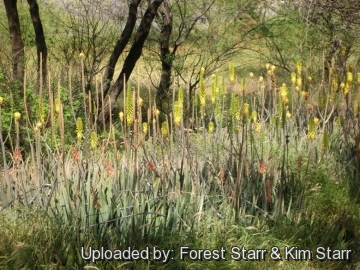 Habit at Honokanaia, Kahoolawe, Hawaii (USA). March 01, 2005. Photo by: Forest Starr & Kim Starr
Habit at Honokanaia, Kahoolawe, Hawaii (USA). March 01, 2005. Photo by: Forest Starr & Kim Starr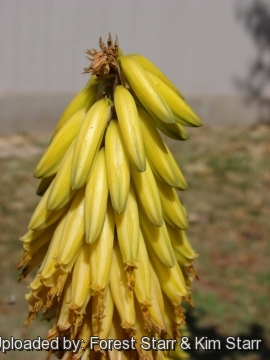 Flowers at Pukalani, Maui, Hawaii (USA). March 02, 2007. Photo by: Forest Starr & Kim Starr
Flowers at Pukalani, Maui, Hawaii (USA). March 02, 2007. Photo by: Forest Starr & Kim Starr Flowers at Honokanaia, Kahoolawe, Hawaii (USA). December 22, 2009. Photo by: Forest Starr & Kim Starr
Flowers at Honokanaia, Kahoolawe, Hawaii (USA). December 22, 2009. Photo by: Forest Starr & Kim Starr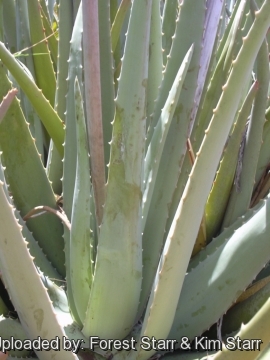 Leaves at State nursery Kahului, Maui, Hawaii (USA). May 23, 2003. Photo by: Forest Starr & Kim Starr
Leaves at State nursery Kahului, Maui, Hawaii (USA). May 23, 2003. Photo by: Forest Starr & Kim Starr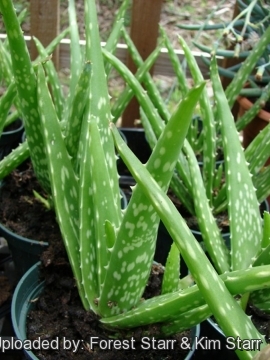 Habit (Juvenile specimen with spotted folliage) at Kula Ace Hardware and Nursery, Maui. September 06, 2007. Photo by: Forest Starr & Kim Starr
Habit (Juvenile specimen with spotted folliage) at Kula Ace Hardware and Nursery, Maui. September 06, 2007. Photo by: Forest Starr & Kim Starr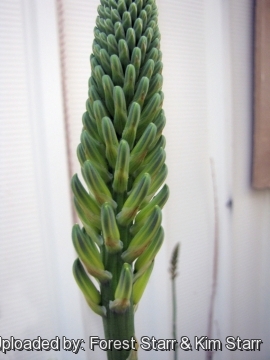 Flower buds at Honokanaia, Kahoolawe, Hawaii (USA). December 18, 2012. Photo by: Forest Starr & Kim Starr
Flower buds at Honokanaia, Kahoolawe, Hawaii (USA). December 18, 2012. Photo by: Forest Starr & Kim Starr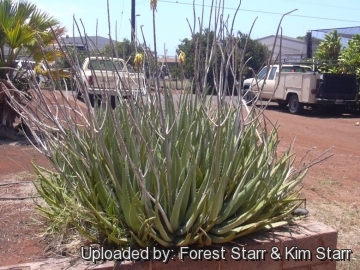 Habit at State nursery Kahului, Maui, Hawaii (USA). May 23, 2003. Photo by: Forest Starr & Kim Starr
Habit at State nursery Kahului, Maui, Hawaii (USA). May 23, 2003. Photo by: Forest Starr & Kim StarrCultivation and Propagation: Very commonly encountered, it is a resistant plant that tolerates poor soil and drought, but requires excellent drainage and usually does not give many problems in cultivation. It is a particularly fast-growing, tough and adaptable species. Needs bright sunny conditions but enjoy some shade in summer. Abundant irrigation at time of growth. The plants favour mild to hot summers. They can resist some cold and occasional snow in the rainy season although the frosts produce wounds and burns that disfigure their aspect. Needs protection only against severe frost. (The leaf tips get damaged below -3°C).
Grow it in light, fertile, well-drained, moderate soils, with a slightly acidic pH (5-6).
Plant in rock gardens and flower pots. Also suitable for coastal planting.
It is a profusely suckering species, and one plant can eventually cover a large area. The plant in itself is very tough and can survive often for several seasons without water, at which point the leaves turn a reddish colour, a sign generally associated with stress.
Maintenance: Removal of old flower stalks; Divide the crowded clumps periodically. During the winter months A. vera may become dormant, during which little moisture is required, and the plants should be grown cool to initiate flower development (about 5-10°C ) In areas that receive frost or snow the species is best kept indoors or in heated glasshouses.
Propagation: By division of offshoots that develop around the outside of the main rosette in spring. The best results are achieved by simply making stem cuttings. Allow cuttings to dry for a few days and insert into river sand and keep moist. The roots appear after about two weeks.
Uses: Aloe vera is renowned for its medicinal and cosmetic uses, however scientific evidence for the the effectiveness of Aloe vera is limited and contradictory. Its leaf containing 12 vitamins and several other active ingredients. It is widely used in alternative medicine. The moist gel inside the Medicinal Aloe leaves is used for the treatment of burns, cuts, sunburn, eczema and other skin complaints. It is also widely used in cosmetics. As a food, A. vera is very bitter and unpalatable and mildly toxic if ingested.
Your Photos
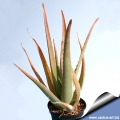
by Cactus Art
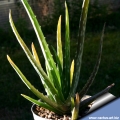
by Cactus Art





















